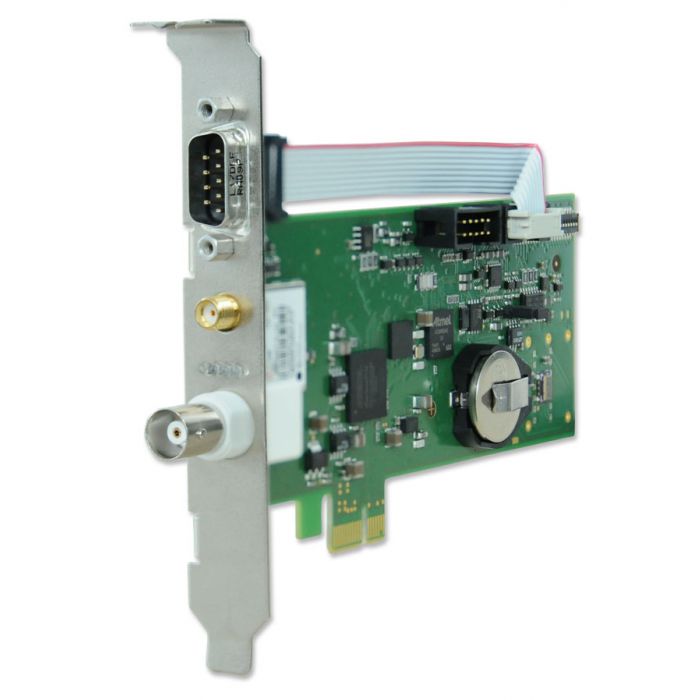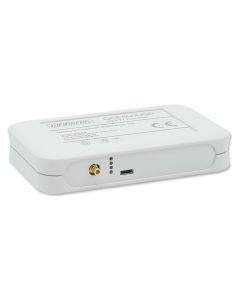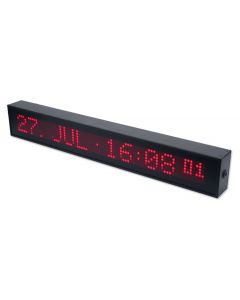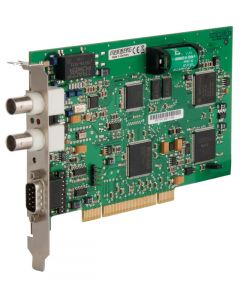
GNS181PEX
GNS181PEX
Meinberg
Low Profile GPS / GLONASS / Galileo / BeiDou Clock (PCI Express)
The board GNS181PEX is designed as a low profile board for computers with PCI Express interface. The rear slot cover integrates the SMA antenna connector, a BNC connector for modulated time codes, a 9pin D-SUB male connector and four status LEDs (2mm light pipes). With this standard height bracket you can use the D-SUB connector for I/O signals like RS-232 - PPS and PPM and you can use this interface for firmware updates.
The GNS181PEX is delivered including a low profile bracket. You can mount this part instead of the standard bracket, to run the GNS181PEX in computers with smaller housing (e.g. 1U server).
The integrated GNSS receiver requires an external antenna. It can be configured to use GPS, Galileo, Beidou and GLONASS. The configuration allows the user to select one of these sources to be used exclusively or a combination with up to three of these sources:
GPS
GLONASS
BeiDou
GPS + GLONASS
GPS + BeiDou
Galileo
GPS + Galileo
Galileo + GLONASS
Galileo + BeiDou
GPS + Galileo + GLONASS
GPS + Galileo + BeiDou
The GNS181PEX is delivered including a low profile bracket. You can mount this part instead of the standard bracket, to run the GNS181PEX in computers with smaller housing (e.g. 1U server).
The integrated GNSS receiver requires an external antenna. It can be configured to use GPS, Galileo, Beidou and GLONASS. The configuration allows the user to select one of these sources to be used exclusively or a combination with up to three of these sources:
GPS
GLONASS
BeiDou
GPS + GLONASS
GPS + BeiDou
Galileo
GPS + Galileo
Galileo + GLONASS
Galileo + BeiDou
GPS + Galileo + GLONASS
GPS + Galileo + BeiDou
Contact us for lead time
Click below to request a quote for this item. Or for product advice, stock and lead time enquiries call our team on 0330 313 3220.
| Attribute | Value |
|---|---|
| Manual URL | https://www.meinbergglobal.com/download/docs/manuals/english/gns181pex.pdf |
| Relative Humidity | Max. 85% |
| Further information |
This PCI Express slot card is the best choice for adding a highly accurate time base to your servers or workstations. It can be used as a stratum 0 reference time source for NTP and transforms any machine into a Stratum 1 NTP server without consuming additional physical space in your server room.
The GNS181PEX comes with a truckload of features to enable software developers to overcome the timing limitations of COTS operating systems like Linux or Windows. The powerful and highly functional Meinberg API (Application Programming Interface) delivers an easy to use and portable way of accessing all Meinberg bus level timing devices, including ISA, PCI, PCI-X, PCI Express and USB time Synchronisation products. Legacy interfaces like IRIG, 1PPS or serial time strings can be used to connect other equipment to the PCIe slot card and transfer the time base over dedicated cable connections to systems which cannot be Synchronised via NTP or other network protocols. The new Memory Mapped Access feature offers a fast, simple and efficient way of reading the current time with high precision. The drivers package for Windows contains a time adjustment service which runs in the background and adjusts the Windows system time continuously and smoothly. A monitor program is also included which lets the user check the status of the device and the time adjustment service, and can be used to modify configurable parameters, if run with administrator rights. The driver packages for Linux and FreeBSD contain a kernel driver which allows the board to be used as a reference time source for the NTP daemon which is shipped with most Unix-like operating systems. This also turns the computer into an NTP time server which can also provide accurate time to NTP clients on the network. Some command line tools can be used to setup configurable parameters and monitor the status of the board. For usage of the card on other operating systems please contact Meinberg support: [email protected]. The device's serial port is not required for operation but can be used to update the card's firmware, or provide another computer with the current time via a serial time string. Satellite receiver for mobile applications: The GNSS timing board is designed for operating in mobile environments like cars, trains or airplanes. An optimized active GPS antenna RV-76 with 10 meters coax cable RG-58 for operation in mobile environment is still available. |
| RoHS | Yes |
| Product Type | PCIe Clocks |
| Status info |
Status info by 4 LED light indicators (2mm light pipes)
Init - blue: while the receiver passes through the initialization phase Nav Solved - green: positioning successfully Ant Fail - red: antenna faulty or not connected Fail - red: time is not Synchronised |
| Frequency Outputs | Frequency output 10 MHz, TTL level |
| Pulse outputs |
3 Programmable TTL outputs, per default configured as:
Channel 0: Pulse per second (TTL, RS232 level), pulse duration: 200 msec Channel 1: Pulse per minute (TTL), pulse duration: 200 msec Channel 2: DCF77 compatible pulses (TTL level), pulse width: 100/200 msec |
| Accuracy of Pulse Outputs |
Depends on oscillator option:
< ±100ns (TCXO, OCXO LQ) < ±50ns (OCXO MQ, OCXO HQ) Standard: TCXO |
| Data format of interfaces |
Baudrate: 300, 600, 1200, 2400, 4800, 9600, 19200 Baud
Data format: 7N2, 7E1, 7E2, 8E1, 8N1, 8N2 Time telegram: Meinberg Standard-Telegram, SAT, Uni Erlangen (NTP), SPA, NMEA0183 (RMC) or capture-telegramm |
| Generated Time Codes |
IRIG B002: 100pps, DCLS signal, no carrier, BCD time of year
IRIG B122: 100pps, AM sine wave signal, 1 kHz carrier, BCD time of year IRIG B003: 100pps, DCLS signal, no carrier, BCD time of year, SBS time of day IRIG B123: 100pps, AM sine wave signal, 1kHz carrier, BCD time of year, SBS time of day IRIG B006: 100 pps, DCLS Signal, no carrier, BCD time-of-year, Year IRIG B126: 100 pps, AM sine wave signal, 1 kHz carrier frequency, BCD time-of-year, Year IRIG B007: 100 pps, DCLS Signal, no carrier, BCD time-of-year, Year, SBS time-of-day IRIG B127: 100 pps, AM sine wave signal, 1 kHz carrier frequency, BCD time-of-year, Year, SBS time-of-day IEEE1344: Code according to IEEE1344-1995, 100pps, AM sine wave signal, 1kHz carrier, BCD time of year, SBS time of day, IEEE1344 expansion for date, time zone, daylight saving and leap second in Control Functions Segment C37.118: Like IEEE1344 - with turned sign bit for UTC-Offset AFNOR: Code according to NFS-87500, 100pps, AM sine wave signal, 1kHz carrier, BCD time of year, complete date, SBS time of day |
| Electrical Connectors |
SMA connector for antenna
BNC female connector for modulated timecode 9 pin sub D male connector (with standard bracket) |
| WEEE status of the product | This product is handled as a B2B category product. In order to secure a WEEE compliant waste disposal it has to be returned to the manufacturer. Any transportation expenses for returning this product (at its end of life) have to be incurred by the end user, whereas Meinberg will bear the costs for the waste disposal itself. |
| Unmodulated Time Code Output | DCLS, TTL into 50 ohm (active high or active low) |
| Modulated Time Code Output | IRIG AM sine wave signal: 3Vpp (MARK), 1Vpp (SPACE) into 50 ohm |
| Type of Antenna |
40 dB Multi GNSS L1
Antenna with Integrated Lightning Protection for GPS, Galileo, GLONASS and Beidou signals Frequency Band: 1575.42 ± 10 MHz / 1602-1615 MHz Antenna Gain: ≥ 3.5 dBic / ≥ 3 dBic Nominal Impedance: 50 ohms |
| Oscillator Options | OCXO-LQ, -MQ or -HQ (instead of TCXO) for extended Holdover capabilities (see oscillator table for further details) |
| Synchronisation Time |
Max. 1 minute in normal operation mode, approx.
12 minutes after a cold start (discharged buffer battery) |
| Backup Battery Type |
When main power supply fails, hardware clock runs free on quartz basis, almanac data is stored in RAM
Life time of lithium battery min. 10 years |
| Board type | Low Profile card (68,90 x 150 mm) |
| Receiver |
Combined GPS / Galileo / GLONASS / BeiDou receiver
Number of channels: 72 Frequency band: L1 Standard Precision (GNSS) |
| Statusbyte | Informations about free running mode, daylight savings time and DST pre-switch announcement, Synchronisation since last reset, GMT/UTC time and validity of the hardware clock data |
| Time Trigger Inputs | Resolution: 100 nsec, triggered by falling TTL slope Time of trigger events readable via API call or serial port |
| Computer Interface |
Single lane (x1) PCI Express (PCIe) Interface
PCI Express r1.0a compatible |
| Navigation Features |
The satellite receiver can determine its position under the following conditions:
an acceleration of up to 5G a speed of up to 500 m/s an altitude of up to 18,000 meters |
| Key Features |
PCI Express Interface
2 time trigger inputs Programmable Pulse Outputs Frequency Synthesizer and Time Code Mode Memory Mapped I/O time reads for high access rates RS-232 interface IRIG-B/AFNOR time code outputs Plug and Play DCF77-simulation Antenna connected with up to 70m of coax cable type Belden H155 Configurable time scale (UTC/local, GPS time, TAI) Driver software for all popular operating systems Possible usage in mobile applications Including 40 dB Multi GNSS L1 antenna, 20m pre-assembled Belden H155 cable and technical documentation on USB key |
| Operating Temperature | 0 ... 50°C / 32 ... 122°F |
| Interface | Single serial RS-232 interface |
| Attribute | Value |
|---|---|
| Data Sheet | Click here to view |






